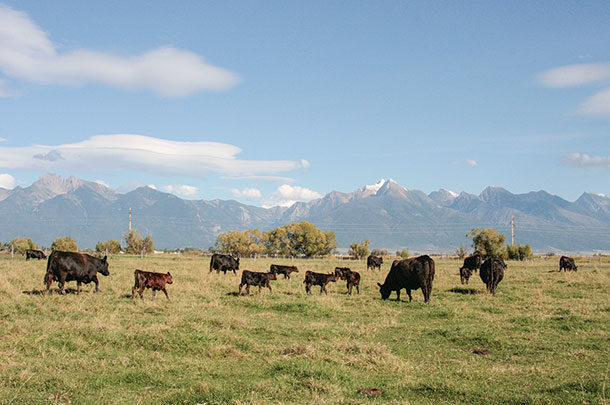This fall, any fall for that matter, is a great time to take soil samples, come up with a liming and fertilization plan based on soil analysis, and apply the recommended amendments and nutrients to establish a new field or keep an older stand functioning well.Are your pastures and hayfields less productive lately? Are legumes in the stand diminishing and more weeds appearing? More winterkill? Slow to green up in the spring? Is it so bad that only a complete renovation will fix it?
Soil fertility and rain are key inputs for maintaining the yield, quality and persistence of pastures and hayfields. Pray for rain, but use soil sampling and analysis to manage soil fertility. Although the symptoms of poor fertility are easy to see – lackluster growth, thinning stands, less clover, nutrient deficiency symptoms – soil pH and nutrient levels cannot be seen with the naked eye.
This fall, any fall for that matter, is a great time to take soil samples, come up with a liming and fertilization plan based on soil analysis, and apply the recommended amendments and nutrients to establish a new field or keep an older stand functioning well.
Especially before investing big money in land preparation and seed to plant a new field, make sure you create the soil conditions necessary to allow forages to thrive, produce high-yield and quality forages, and last a long time.
Taking a good soil sample
The answer is only as good as the question. Taking a good soil sample is essential to finding out what and how much lime and fertilizer is needed.
- Most soils should be sampled at least every three or four years. Sandy soils and intensively managed fields (alfalfa, silage, hayfields) should be sampled every one or two years.
- Take soil samples to a depth of 8 inches before establishing a new forage field or renovating an old stand. In established forages, take samples to a 4-inch depth.
- Soils are highly variable, so samples should be taken from uniformly managed areas of 25 acres or less. Identify areas of the field needing separate samples based on differences in soil type or landscape position. A soils map (Web Soil Survey) can help you locate different soil types in established forages.
- Each sample area should be represented by a pint subsample taken from a well-mixed sample consisting of 20 to 30 individual core samples (about 1 inch in diameter) taken from throughout the area in a random or zigzag fashion.
- Send soil samples to a laboratory that uses procedures appropriate for your area. Analyses should include pH, plant-available phosphorus (P), potassium (K), calcium (Ca) and magnesium (Mg). Analysis for micronutrients (for example, zinc, manganese and copper) can be obtained for an additional cost, but shortages of these nutrients are not likely in most situations.
Typically, soil testing is not a good approach to determining nitrogen (N), sulfur (S) or boron (B) availability for crops. Nitrogen recommendations are often made for non-legumes based on the expected yield of the forages.
Boron and sulfur are routinely recommended for crops sensitive to deficiencies of these nutrients (alfalfa, for example) and when soil conditions (sandy, low organic matter) increase the likelihood of shortfalls. Tissue testing should be considered to evaluate the adequacy of N, S and B if deficiencies are suspected.
Soil pH and liming
Proper pH is important to forage root health and function and the establishment and productivity of bacteria associated with the roots of legumes (like alfalfa and clover). Optimum pH is generally between 6.0 and 7.5, with the higher pH levels being beneficial for alfalfa and clover but not non-legumes.
Although soil pH that is too high can be detrimental to nutrient availability, it is not practical to lower pH when high pH is a result of the soil parent material.
Soil pH is increased with limestone. Since limestone reacts slowly to increase pH, it is best to apply it at least three months before establishing a forage stand. Thoroughly mixing limestone into the soil with tillage is beneficial because it hastens the change in pH and affects a larger volume of soil.
Surface limestone applications change pH slowly, so they are best for maintaining soil pH, not for correcting low soil pH. So don’t allow soil pH to fall below 5.8.
Limestones can be composed of varying amounts of Ca and Mg carbonates. Calcitic limestone, sometimes referred to as high-cal lime, may have almost no Mg. Dolomitic limestone can have up to a one-to-one mixture of Ca and Mg carbonate.
Adequate Mg reduces the likelihood of tetany. If soil analysis shows adequate Mg, then either type of limestone can be used, but if soil Mg is low, a dolomitic limestone is the least expensive source of Mg. Either limestone type will provide adequate Ca.
Phosphorus and potassium soil testing and fertilization
Phosphorus and K are relatively immobile in soils, so it is possible to establish adequate to high soil test levels of both nutrients before establishing a forage crop. Soil test P levels for alfalfa should be in the 25 to 40 parts per million (ppm) range based on the Bray soil test method, while 15 to 30 ppm is sufficient for other forages.
Adequate K levels vary in the range of 90 to 125 ppm (based on ammonium acetate extractable or Mehlich 3 methods), with lower levels needed on sandy soils and higher levels on clay soils. Surface applications of P and K, particularly if the soil test level is low, will be less effective than incorporated applications.
Hay and silage crops remove larger quantities of P and K from the field as compared to pastured forages, so they will need to be applied periodically. Fertilizer application rates should be based on additional soil testing or estimates of crop nutrient removal.
Commonly grown forages remove 12 to 15 pounds of P2O5 and about 50 to 60 pounds of K2O per ton of forage on a dry matter basis.
High K can induce grass tetany and milk fever in livestock. Moderate, annual K applications after the first and last harvests are less likely to cause either of these disorders than heavy applications in the spring.
Summary
Soil testing and following through with the application of recommended limestone and nutrients based upon the test results is a “best management practice” that cannot be neglected. If it is, yield, quality and persistence of forages will likely be negatively impacted. ![]()
Keith Johnson is a professor of agronomy at Purdue University. Email Keith Johnson.
PHOTO: Soil deficiencies can’t be seen with the naked eye – only the results; and by the time you see thinning stands and lackluster growth you’re already behind in the game. Photo by Paul Marchant.

-
James J. Camberato
- Professor of Agronomy and Extension Specialist
- Purdue University
- Email James J. Camberato













